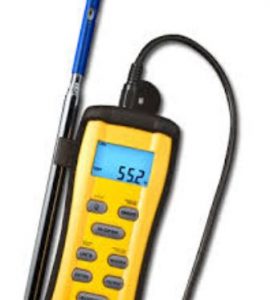The way water reacts to the surface, where it stays is obvious. When it vaporises, the surface cools. It works practically the same way when sweat cools your body when it evaporates. But when water evaporates, the air where it goes has a limit to its capacity to hold the vapour. When it is full, the air is humid. It means that the air is saturated filled with as much water as it can keep, and water does not quickly vaporise.
If you’re wondering why we’re talking about this, the answer is because it is relevant when it comes to learning how an instrument called the psychrometer works.
A psychrometer refers to a type of hygrometer, which is exclusively utilised to determine the relative humidity or moisture content in the air. Traditional psychrometers embody the older humidity measurement form and electronic sensors, which in turn depends on the changes in electrical resistance and capacitance instead of the condensation temperature that’s preferred these days.
Are you wondering what a psychrometer & where to find them? The answer is it is a device usually found in industrial settings. The modern and newer versions come in mobile and stationary models. However, be reminded that a psychrometer is likewise a useful tool in a residential environment. The device will measure the quantity of water vapour in the air. It is referred to in the scientific community as relative humidity.
Meanwhile, relative humidity describes the moisture content in the air compared to how much moisture the air can hold for a specific temperature. Information about the relative humidity is crucial for someone who wants to obtain a deep understanding of the weather condition.
 Accordingly, the psychrometer serves the purpose as it counts both the wet-bulb and dry-bulb temperatures. Keep in mind that a couple of thermometers are required to compute the constraints. You get the relative humidity from those values.
Accordingly, the psychrometer serves the purpose as it counts both the wet-bulb and dry-bulb temperatures. Keep in mind that a couple of thermometers are required to compute the constraints. You get the relative humidity from those values.
So, why is it vital to know relative humidity? The answer is that it helps you understand what to expect from the weather.
One thing you must understand about a psychrometer is that it is made up of a dry-bulb and wet-bulb thermometer. The dry bulb serves the purpose of measuring the temperature. It does not have any covering to achieve maximum exposure to air. On the other hand, the wet-bulb must be kept wet. Therefore, it usually is covered with some damp cloth or sock or dipped in water. Once you are ready to use it, you must remove the wet-bulb from the water.
Gathering information about relative humidity and dewpoint using a psychrometer requires calculations that are usually time-consuming, especially if you don’t have the benefit of intuitive software. Hence, it makes sense to use a psychrometric chart to ensure a convenient way of gathering the information you need.